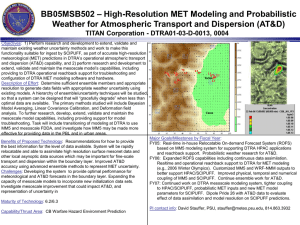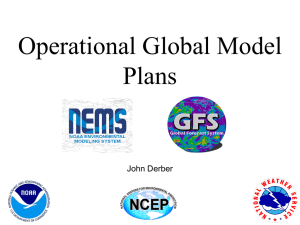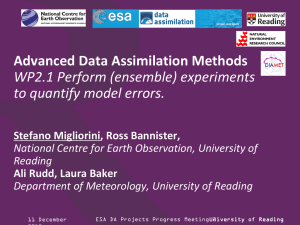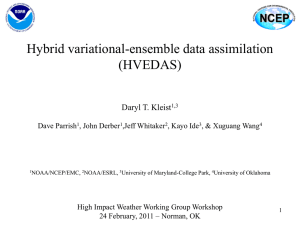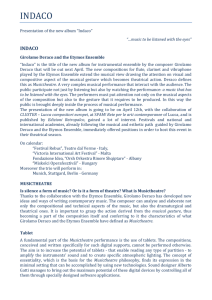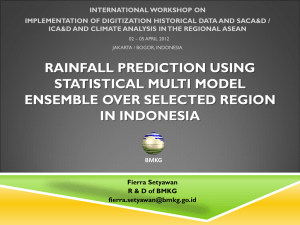Does mesoscale instability control sting jet variability?
advertisement
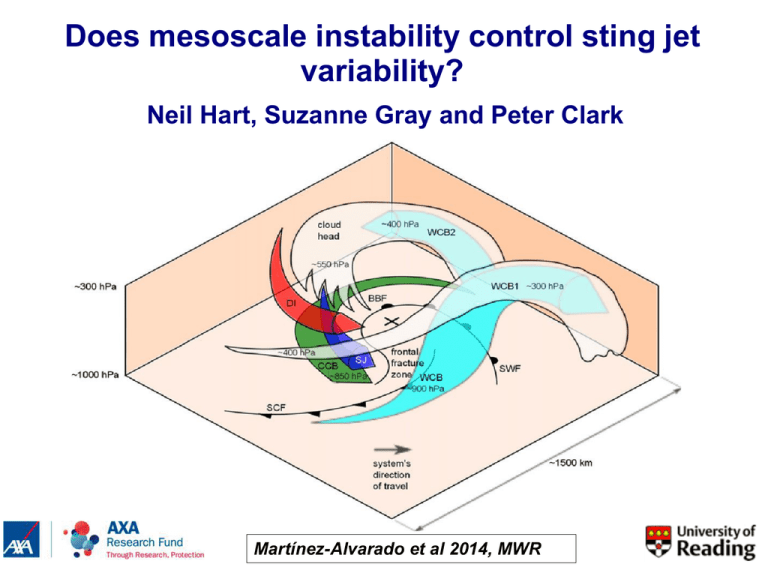
Does mesoscale instability control sting jet variability? Neil Hart, Suzanne Gray and Peter Clark Martínez-Alvarado et al 2014, MWR Instability and Predictability Convective Instability ~1km ~30mins Symmetric Instability ~100km ~6hours Baroclinic Instability ~1000km ~day St Jude Forecast:Global Ensemble Courtesy: ECMWF St Jude Forecast: MetOffice 4km Courtesy: MetOffice St Jude Forecast: MetOffice UKV IR satellite image at 0600 UTC Courtesy: MetOffice & EUMETSAT Why mesoscale instability? • Browning 2004 hypothesized that Conditional Symmetric Instability (CSI) in the cloud head cloud is an explanation for the fingering seen in satellite imagery at the tip of some cloud heads • The resulting slantwise circulation would see ascent into the cloud head with descent near the cloud head tip • This hypothesizes a mechanism for sting jet descents, as seen in 1987 Great Storm Fig. 14 Browning 2004, QJRMS Why mesoscale instability? T -10hrs Shading is number of pressure levels between 800hPa and 600hPa, that have CSI (MPVS*<0) Blue circle indicates position of air parcels manually identified as part of the sting jet descent Moist Baroclinic LC1 experiment Fig. 7 Baker et al 2013, QJRMS Why mesoscale instability? T -6hrs Shading is number of pressure levels between 800hPa and 600hPa, that have CSI (MPVS*<0) Blue circle indicates position of air parcels manually identified as part of the sting jet descent Moist Baroclinic LC1 experiment Fig. 7 Baker et al 2013, QJRMS Why mesoscale instability? T -2hrs Shading is number of pressure levels between 800hPa and 600hPa, that have CSI (MPVS*<0) Blue circle indicates position of air parcels manually identified as part of the sting jet descent Moist Baroclinic LC1 experiment Fig. 7 Baker et al 2013, QJRMS Friedhelm, Robert and Ulli Friedhelm 8 Dec ‘11 Robert 27 Dec ’11 Martínez-Alvarado et al 2014, MWR Identified with DSCAPE diagnostic applied to ERA-Interim (after Martínez-Alvarado 2012) Ulli 3 Jan ‘12 Smart & Browning 2013 Cyclone Robert Courtesy: EUMETSAT, Sat24.com Methodology Friedhelm 8 Dec ‘11 Robert 27 Dec ’11 Ulli 3 Jan ‘12 1. Produce 24 member ensemble simulations of each storm 2. Compute back trajectories from low-level jet region of each member 3. Cluster analysis to classify trajs. to identify descending airstreams 4. Explore link between these descents and CSI across ensemble Model Setup • MetOffice Unified Model vn8.2 • MOGREPS-Global ETKF 24 Init. Pert. Members (Bowler et al, 2008) • MOGREPS-Regional • N. Atl. & Europe Domain • • 12km, 70 Levels All storms initialised at 18 UTC the day before maximum intensity • Results analysed further are T+10 to T+24 forecasts Synoptic Overview Synoptic Overview Small spread in synoptic scale evolution between ensemble members: Good, since can now focus on mesoscale differences Compute Back Trajectories Control Run from Cyclone Robert ensemble Compute Back Trajectories Cloud Top Temperature 850hPa 45m/s Isotach Control Run from Cyclone Robert ensemble Compute Back Trajectories Trajectories Computed with Lagranto (Wernli & Davies, 1997) Control Run from Cyclone Robert ensemble Classification of Airstreams Cluster Class Mean Trajectories: Each trajectory described by x,y, P, θw for 5 hours preceding arrival in low-level jet Identify class means that descend Use Relative Humidity to remove descents that started outside cloud head Ward’s Hierarchical Clustering Algorthim Classification of Airstreams Identify class means that descend Use Relative Humidity to remove descents that started outside cloud head Ward’s Hierarchical Clustering Algorthim Classification of Airstreams Identify class means that descend Use Relative Humidity to remove descents that started outside cloud head Classification of Airstreams Use Relative Humidity to remove descents that started outside cloud head Classification of Airstreams Classification of Airstreams Each Class contains a population of individual trajectories that arrive at given time. Next slide Size of these populations are gathered for all descent classes at all times for each ensemble member 1600 # of Traj. Arriving in LLJ 1600 # of Traj. Arriving in LLJ Majority of of ensemble members have peak in # trajs at 12UTC Ensemble Sensitivity Control run 281K θw 850hpa Control run cloud head X Interpret as change in # trajs for 1 s.d change in CSI metric Ensemble Sensitivity X Methodology after Torn & Hakim 2008 Ensemble Sensitivity X Methodology after Torn & Hakim 2008 Ensemble Sensitivity X Methodology after Torn & Hakim 2008 Ensemble Sensitivity X Methodology after Torn & Hakim 2008 Conclusions Consistent synoptic development across ensemble Considerable variability in mesoscale wind features Demonstrated method to classify descending airstreams Large variability in number of descending trajectories across ensemble Does mesoscale instability control sting jet variability? Strength of sting jet descent is associated with CSI in the cloud head (in Robert as simulated with MetUM) Cyclone Friedhelm Cyclone Friedhelm Comparison to Martinez- Alvarado et al 2014 manual classification # trajs Ensemble Sensitivity CSI across ensemble If correlation > threshold (0.5 used here), good! # trajs Ensemble Sensitivity ∆y ∆x CSI across ensemble Calculate Gradient # trajs Ensemble Sensitivity ∆y ∆x CSI across ensemble Ens. Sensitivity = ∆y (∆x = 1 s.d.)

